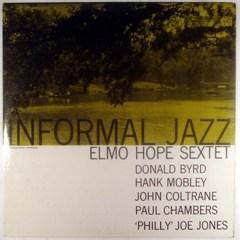Elmo Hope - Informal Jazz (1956)
Elmo Hope - Informal Jazz (1956)

01 Weeja (Hope) 02 Polka Dots and Moonbeams (Burke, Van Heusen) 03 On it (Hope) 04 Avalon (Jolson, DeSylva, Rose) Musicians: Donald Byrd (trumpet) John Coltrane (tenor sax) Hank Mobley (tenor sax) Elmo Hope (piano) Paul Chambers (bass) Philly Joe Jones (drums)
The Prestige label turned out records like this at the rate they roast ducks in Chinatown, and there are plenty of happy souls who can't get enough of either. If this particular session hasn't assumed the legend of a jazz classic, it's because, on the whole, some little spark seems to be missing. If this element could be defined easily, and put into words quickly and efficiently, then record producers and musicians would know exactly how to create the perfect jam session record. The people involved in this record know much more about such a science then the average musician and record producer. These are musicians very far down the road from being average, all of this underscoring the difficulty of creating a spontaneous recording session at which moments of improvisational genius are expected to pop up.
While the album's title is another example of how cleverly labels such as this can describe what they are selling, there are really many aspects of these proceedings that are hardly informal at all. Describing these in the order in the importance, the obvious place to start is the drum and bass team of Philly Joe Jones and Paul Chambers. The playing of these gentlemen here is worth the price of the record alone, even if the copy is secured from a tightwad used-record store owner somewhere in the Ozarks who only opens the doors of his establishment for gold credit card owners. This is hardly the kind of rhythm section playing heard at a jam session, except possibly in heaven.
Elmo Hope mans the piano bench at the helm of this dream team, and while the liner notes call him the "nominal leader" for the blowing date, he earns actual leader status by accomplishing two things. First, his solo spots are the best part of the record, especially the part of "Weeja" where even Jones drops back, eventually adding some strange filigree. At this point the rhythm section seems to be making a statement about having gone through the rigmarole of backing all the previous horn solos in an exercise that is supposed to produce great moments of jazz, but maybe didn't. They play as if in relief, as if happy it is up to them for a change. What happens is truly memorable, but it sounds more like professional musicians who have worked together many times hitting a genius moment, not a jam session.
Second, Hope provides original material that helps give the record its personality. It is typical to pass off the tunes at sessions such as this as just simple contrivances to launch soloists, but again it is a stretch to imagine an "informal" recording session where even material as complicated as this is played. Both of the standards have arrangements that would leave jazz students, and some of their teachers, tying their shoes on the bridge. Hope's "Weeja" has a simple fanfare of a theme, sure, but it is arranged within a nifty series of short blowing spots. This is where the merry listener gets the treat of hearing Donald Byrd, Hank Mobley, and John Coltrane introduce themselves instrumentally, the latter tenor giant making a great ride of the bridge. Everything is tight, together, and without a hitch. Squeaking mouthpieces from Mobley and Coltrane are the only casual aspects.
These tenor titans are promoted as being involved in reviving the instrumental battle popularized by Gene Ammons and others here, but a real duel would require some kind of interaction between the participants. Mobley and Coltrane really don't seem to be paying much attention to each other, pursuing their own agendas. Mobley has the whisk broom and the fluff brush, enjoying an effortlessly fluid tone with a sound a bit like Warne Marsh at times. Coltrane continually blasts ringing melodic variations on various hard bop licks, each of them worthy of being chiseled into marble. The trumpeter's acrobatics are familiar, pole-vaulting through the changes, running the 440 through the bridge, then a standing broad jump in the trades with Jones. Can anyone else play like Byrd? It hasn't happened yet. The overall best performance is probably "Polka Dots and Moonbeams" -- since it is the one slow tune of the bunch, it gets the most special treatment. Shorn of nothing but moments of sheer brilliance, a shorter and better version of this album would feature only the piano solos and the parts where everyone trades fours with the drummer. --- Eugene Chadbourne, Rovi
download: uploaded anonfiles yandex 4shared solidfiles mediafire mega filecloudio








